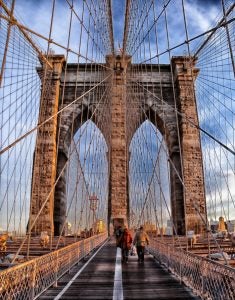Tasha Kosviner, Environment Writer/ Editor
This blog originally appeared on Medium.

Brooklyn Bridge
Most Fridays, my eight-year-old son and I take a walk. Our route takes us across some of the busiest traffic intersections in Brooklyn. As we walk, we talk. My son has lots to say and he bounces from topic to topic in funny and unexpected ways. This being New York, we often have to shout over the sound of car horns, sirens and buses roaring away from curbs.
Earlier this year, our conversation centered around the little white gadget clipped to my bag. Known as an AirBeam, it was personal air quality monitor, able to sense and measure the pollution in the air around us as we walked. The data it gathered was fed, via Bluetooth, to an app on my phone, giving us real time information about what was in the air we were breathing. What we saw was sobering.
With increasing global concern about air pollution, the availability of, and interest in, wearable air quality monitors has accelerated in recent years. In addition to the AirBeam, there is now also the Tzoa, the Flow, the ATMOtube, the CleanSpace Tag. A quick search of crowdfunding sites like Kickstarter and GoFundMe reveals multiple new monitors under development all claiming to give us the lowdown on what’s in the air around us.
Many of these gadgets stream their measurements straight to your smartphone. The AirBeam uses an open-source platform, AirCasting, and the information appears in ever evolving graphs which dip and peak as you move through space and time.
For most of mine and my son’s Friday walk, the lines remained reassuringly green and steady. But as we crossed a bridge above the Brooklyn-Queens Expressway, with traffic flying beneath our feet, the PM2.5 line (so-called because the particles detected are less than 2.5 micrometers in diameter, or one-thirtieth the size of a human hair) suddenly spiked and turned a traffic light red. We stood together and watched it silently for a few seconds.
“What does it mean?” my little boy asked.
I hesitated. The air around us looked clear, the sun shone, the people looked the same. Whatever was happening in the air above that expressway, New York (no surprise here!) didn’t seem to care. Staring at that red line, I realised I didn’t really know what it meant either. Could we stay and safely breathe that air? How long before it started to affect our health? A minute? A week? A year? I did that parent thing and answered without really answering.
“It means we’re moving on,” I tell him. “Let’s walk.”









